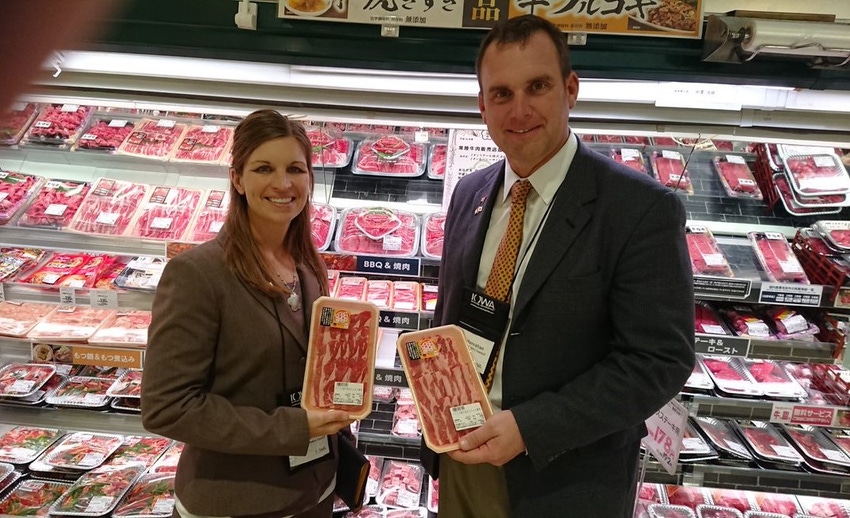South Korea edging forward to compete with Japan for same product.

Japan remains the number-one export market for U.S. beef products, but South Korea, which is currently the number-two export market, is edging forward to compete for the same product, according to the Iowa Beef Industry Council (IBIC).
To better understand the marketplace, IBIC, funded in part by the Iowa state beef checkoff program, recently joined other commodity partners on a meat trade mission to Japan and South Korea.
The mission, led by the Iowa Economic Development Authority and coordinated with the U.S. Meat Export Federation (USMEF), a contractor to the beef checkoff, included meetings with top import companies interested in U.S. beef. Tamara Heim, beef farmer and IBIC elected director, and Dan Hanrahan, beef farmer and IBIC director, represented the interests of Iowa’s beef farmers.
According to IBIC, Tokyo, Japan, is the largest metropolitan city in Japan, with more than 10 million people. It is a huge market and continues to grow despite a declining population, IBIC noted. For example, 25% of the population is in the 60- to 70-year age group that has increased meat consumption by 45% since 2006.
“It was welcoming to hear the Japanese government promote the health benefits of beef to their aging population,” Hanrahan said.
Overall, Japan has a high demand for beef, IBIC said.
“As the quantity of Prime-grade beef production continues to increase in the U.S., we need an outlet for this high-quality beef, and Japan fits with our products. The Japanese consumer is demanding a leaner beef as compared to traditional domestic wagyu, and the U.S. Prime grade fits this perfectly,” IBIC said.
Another benefit coming from Japan is consumer demand for variety meats such as intestines and tongues. IBIC noted that beef tongue sells for more than $6.00/lb. in Japan, compared to $1/lb. in the U.S. -- a huge export premium that makes good business sense.
Last, convenience is key in Japan, IBIC said, noting, “From Bento-style lunchboxes to standing steak houses, the Japanese consumer wants convenience.”
Chilled beef imports that feed these convenience markets are up 30%, according to USMEF.
IBIC did caution that the Japanese market may face some difficulty in the future due to the tariff situation. The current tariff on U.S. beef is 38.5%, but competitors Australia, New Zealand, the European Union and Canada will see a reduction in their tariffs that began Dec. 30, 2018.
“This makes U.S. beef more expensive for Japan to import. Market access is critical to the export conversation,” IBIC said.
Korea currently in 'meat boom'
Korea's demand for U.S. meat was exceptional in 2018. USMEF data show that January to October 2018 beef exports to Korea were up 35% in volume (200,666 mt) and up 47% in value ($1.44 billion). January to October 2018 pork exports to Korea increased 41% in volume (191,610 mt) and 44% in value ($538.4 million). Even without the rest of the 2018 numbers in, USMEF said the pork export pace already tops annual records set in 2011.
Although imports from all main suppliers have expanded this year, USMEF said the U.S. share of Korea’s pork imports has increased significantly, rising from 36% to 39%. Currently, Korea imports almost 70% of its beef, and 60% of that has been from the U.S., IBIC noted, adding that the beef trend is amazing considering U.S. beef exports to Korea in 2006 were zero.
“Consumer confidence is currently trending at 52.2%, but lingering fear of [bovine spongiform encephalopathy] is still the limiting factor,” IBIC said.
Still, IBIC said trends contributing to the meat boom include average annual income growth of $10,000 since 2006, the Korean diet becoming more westernized and the overall affordability of meat.
Korea is also a great market for products that are not highly consumed in the U.S., such as ribs, chuck oll (neck) and shoulder clod. Additionally, packaging meat in Korea has a wide range, from large primal cuts to individual servings, IBIC explained.
During the mission trip, Heim had the opportunity to visit Costco in Korea.
He said, “While it looked much like a Midwestern Costco, you could physically see the demand for beef in the amount of people waiting at the meat coolers to pick their cut. More specifically, there were more coolers and consumers hovering around the U.S. beef than our competitors.”
Contrary to Japan, the tariff situation in Korea is beneficial to U.S. beef, IBIC noted.
Tariffs on U.S. beef are currently at 21.3% and are scheduled to go to 0% in 2026. Market access for processed beef will be a great area for growth in this export market but currently is not allowable for export in this country, IBIC said.
Overall, Heim said Asia is a huge market for U.S. beef. The region’s desire for continued relationships with U.S. beef producers resonated and was evident in the meetings, he added.
Expanding beef’s global position
IBIC has a mission to expand U.S. beef’s position in the domestic and global marketplace.
According to USMEF, year to date, the value of the international markets for beef add $318.66 value per head to a fed steer.
“In meeting with Japan's three largest meat processors, it was amazing how many times I heard the names of rural Iowa communities. It was something to be able to talk about Iowa beef and agriculture halfway around the world at a depth some of us might not be able to talk with our own neighbors,” Hanrahan said of the recent mission.
The mission was coordinated by the Iowa Economic Development Authority with representatives from IBIC, the Iowa Pork Producers Assn., the Iowa Corn Promotion Board and several other private business professionals. Checkoff investments with USMEF assisted with many of the in-country meetings while promoting U.S. beef in these countries.
About the Author(s)
You May Also Like





